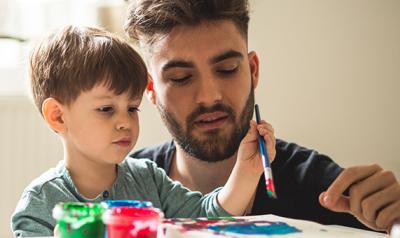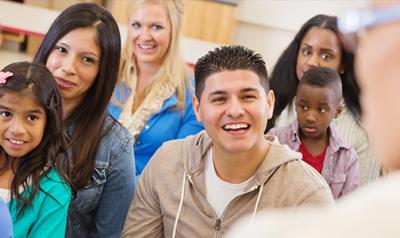A High-Quality Program for Your Preschooler

You are here
On a class nature walk, Matias notices that the leaves, which were once green, are now red, orange, and yellow. He asks his teacher why the leaves are changing colors.
Anna and Xavi build a ramp for their toy cars and test how fast the cars go when the ramp is at different angles.
At the dramatic play center, Megan, Ima, and Luciana set up a pretend doctor's office. They take turns role-playing as the doctor, receptionist, and patient.
These preschoolers are having fun and learning a lot through their play. Children who succeed in school and in life know how to find solutions to problems. They can communicate and work well with others. They are curious, creative thinkers, and they continue to learn and adapt. High-quality preschool programs help your child build these skills.
You might have questions like, What goes on in a preschool program? or Should my child be able to read and write at this age? This page will give you some of the answers. You'll find out about how preschoolers learn and develop, how teachers support their learning and development, and what a high-quality preschool program looks like. Let's get started!
How Preschoolers Develop and Learn
Your child is growing up so fast! One minute he's begging you to read his favorite book with him, and the next he's drawing a spaceship he and his friend want to build. Let's look at how your child builds his skills and knowledge at this age.
By interacting with caring adults. Teachers help your child feel secure and important every day. They listen to your child and get to know him well. When children feel safe and cared for, they grow in all areas of development.
Through active, hands-on, “minds-on” play and learning. As your preschooler plays, experiments, and interacts with children and caring adults, a lot of learning happens. She develops skills that will help her think, question, and explore the world.
By connecting new ideas and skills to what they already know and can do. All of us learn best when we can link new information to what we already know. Teachers help preschoolers do this to build knowledge and connect learning to what interests your child, like bugs or machines!
By exploring and making sense of their world. As your child explores materials, he comes up with ideas about why things happen and tests them out. Teachers help him make sense of his experiences by asking him to explain his thinking, encouraging him to try something different, and adding small challenges.
Through teacher-guided learning. Teachers plan small- and large-group experiences that stretch children's learning. Some strategies they use during these times include
- Giving children many opportunities to practice new skills, like finding and making patterns
- Offering choices so children become more independent and take responsibility for their learning
- Asking questions that lead to more than one right answer: “Why do you think that happened?”
- Giving hints to help children figure out something
- Providing information and directions
- Adding challenges when children are ready for them, like reading aloud slightly longer books with more complex words
- Commenting on what children are doing to call attention to their efforts, not just what they accomplish: “You thought about that really hard before you answered.”
- Giving them time to find their own solutions, and offering help if children seem stuck or frustrated
- Encouraging your child to keep trying and to judge his own efforts: “How did your idea about making a maze with blocks turn out? What do you think you could do differently next time?”
Teachers also think carefully about when, how, and where to help children learn. When they read a book to a small group, they might discuss the characters and point out specific parts of the book, like the title and cover. They might use puppets to help children talk about their feelings. Teachers use every moment to help children learn—including mealtimes, cleanup, and outdoor playtime.
What Does “High Quality” Mean?
No two preschools look or feel exactly the same. But all high-quality programs have some things in common.
Teachers in high-quality programs build on what your child already knows and can do. They provide materials and experiences that are challenging, but that children can do with a little help. This is called developmentally appropriate practice (DAP). Developmentally appropriate practice means
- Teaching based on each child's age and stage of development
- Helping each child meet goals that are just right for that child
- Valuing and including each child's family, language, and culture
When teachers choose materials, activities, and strategies to use with children, they think about many things, including
- What most preschoolers need—like materials for creating and pretending
- What individual children might need—such as a quiet space for Thalia, who's sensitive to loud noises
- Ways to support each child's family, language, and culture—like learning several words in Spanish to speak to Carlos and Yasmina
Using what they know about your child, teachers set goals for her. They keep track of her learning so they know what she's ready to learn next.


